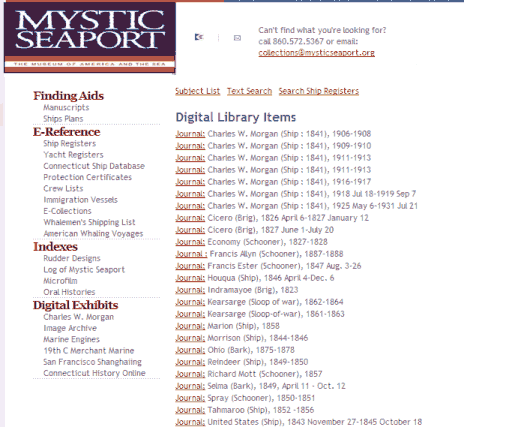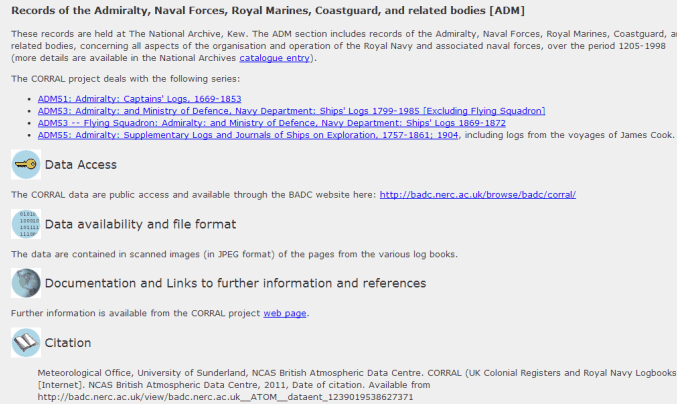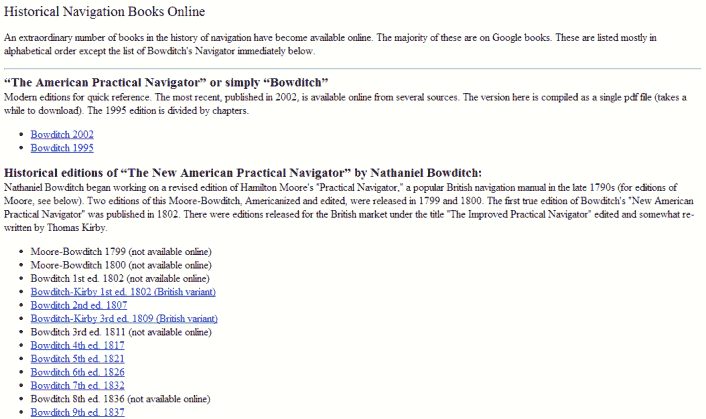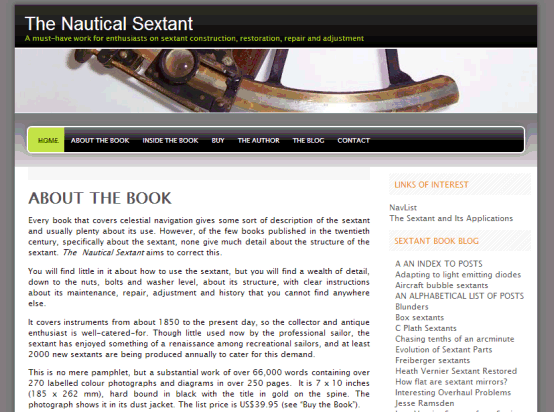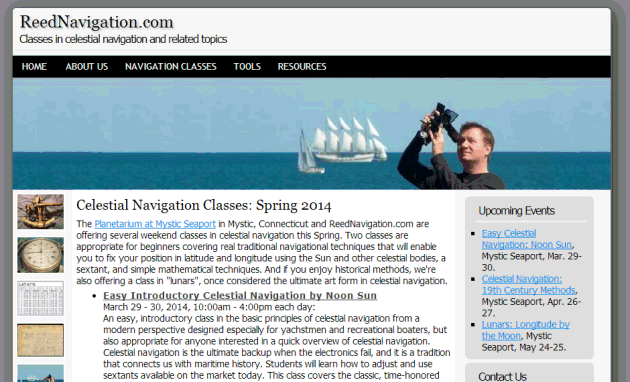
NavList:
A Community Devoted to the Preservation and Practice of Celestial Navigation and Other Methods of Traditional Wayfinding
Errors in Cotter's book, updated
From: George Huxtable
Date: 2003 Jan 8, 10:47 +0000
From: George Huxtable
Date: 2003 Jan 8, 10:47 +0000
Here's an updated list of some things I suspect are wrong in Charles H
Cotter's otherwise-excellent book "A History of Nautical Astronomy". Jan
Kalivoda has kindly helped by confirming some earlier diagnoses and adding
others of his own. If any listmember has others to add, I would be pleased
to receive them.
I doubt if my list, below, is at all exhaustive: I have not deliberately
searched out errors; these are just the ones I have stumbled across in my
own reading. It might be useful to print out the list below and insert it
into your copy of Cotter.
The paging corresponds to my Hollis & Carter 1968 edition, the last page of
its index being 387.. I think there was also a US edition: the paging was
probably identical. I doubt if there were any later editions.
Here goes-
===========================
page 49. The third paragraph starts- "The civil day at sea commenced at
midnight", which is correct. In the next paragraph Cotter states "The civil
day commenced when the Mean Sun culminated at noon." which is
contradictory, and wrong
==========================
page 118, foot of. Cotter states
"Augmentation = Moon's semidiameter x sine apparent altitude". This is wrong.
It would be roughly true to state instead-
Augmentation (in minutes) = Moon's semidiam. (in degrees) x sine apparent
altitude
but more accurate to say-
Augmentation (in minutes) = Moon''s semidiam. (in minutes) x sine apparent
altitude / 55.
==========================
page 120, 2nd line, Cotter says- "... body Y, which has the same APPARENT
place as body X". but fig 5 shows body Y at the same TRUE place as body X.
==========================
page 210-212, Borda's method. Here I think Cotter has got into a real mess
with his trig. The equation that precedes equation (Y) is given as -
(sin D/2)^2 = sin{(M+S)/2 + theta} sin {(M+S)/2 - theta}
Here, he has got the last term the wrong way round and it should be-
(sin D/2)^2 = sin{(M+S)/2 + theta} sin {theta- (M+S)/2}
so in consequence, in equation (Y), the second sine term in the product of
two sines is also reversed.
Similarly in the last equation on page 210, for log sin D/2, the last term
in the sum should end up as log sin (theta- (M+S)/2), not log sin ((M+S)/2
- theta), as Cotter gives it. If you slavishly follow Cotter's steps, you
will end up taking the log of a negative quantity, which is an
impossibility.
I think Cotter has realised there's something wrong, without being sure
what it is, because on page 211 he states the rules in words for clearing
the distance, and in rule 5 he says- "Find the sum of and difference
between theta and phi". Because he hasn't defined here which way round to
take that difference, the navigator will presume that he should subtract in
such a direction as to give a positive answer. So that bit of "fudging" has
got Cotter out of his problem. In fact the subtraction should ALWAYS be
theta - phi, and NEVER as stated at the foot of 210, phi - theta.
On line 3 of page 212, that's what he has written down in the calculation,
theta - phi, just as it should be.
=========================
There's an additional error in Rule 5, page 211, in that the last sentence
should not read-
"The result is the sine of half the true lunar distance, that is D/2.",
but instead-
"The result is the LOG sine of half the true lunar distance, that is D/2."
========================
page 226, Dunthorne's method. Dunthorne's is in fact a rigorous method of
clearing the lunar distance, but Cotter has included it in his list of
approximate methods
========================
page 237. For a navigator, it may be useful to know that alpha Aquilae is
more familiar as Altair, alpha Arietis as Hamal, and alpha Pegasi as
Markab.
=========================
page 250. The four equations shown on this page all use the quantity s,
but I cannot find any definition of s. I presume that s is half the
perimeter of the PZX triangle, so-
s = 1/2 (ZX + PZ + PX)
In the third expression, for cos P/2, a quantity s with a subscript 2
appears. That little 2 appears to be a misprint should be erased.
========================
page 264. Cotter says, about finding the moment of noon by equal Sun altitudes-
"By taking the equal-altitude sights shortly before and after noon the
necessity for applying a correction for the change in the Sun's declination
in the interval is obviated, since any such change will be trifling."
I disagree with Cotter's analysis here. It seems to me that the correction
necessary for a changing declination does not reduce as the interval chosen
gets closer to noon.
===========================
page 265. Re Hall's rule. Cotter introduces delta-d as the correction in
seconds of time..
This ought to be delta-h
and in the equation near the foot of the page, cos h should be cosec h.
page 266. Similarly, in the equation at the top of this page cos h should
be cosec h.
==========================
page 354. Napier's rule. I suspect that the second expression, shown as-
cos x = cos y cos z is wrong, and should be-
cos y = cos x cos z
==========================
It's rather disappointing that so many errors can be found in Cotter, and
indicates some degree of carelessness in the checking and proofreading. But
we can all get things wrong, as I have good reason to know...
The prevalence of these detected errors leaves me suspecting that there may
be many more, lurking as-yet unseen.
They detract somewhat, but not a lot, from the value of Cotter's book,
which remains by far the best source I know to treat the development of
astronavigation, and is a wonderful goldmine of references.
George Huxtable.

